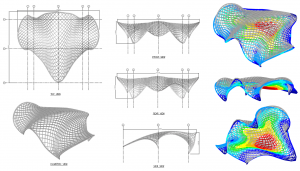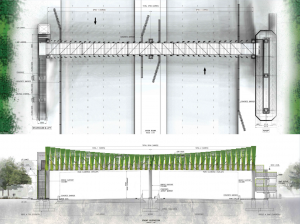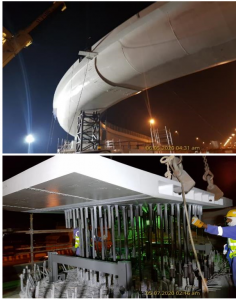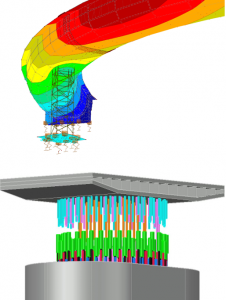The parts of our daily lives we tend to take for granted each and every day are often the most vital to the functioning of society. Think about it. We drive along roads, walk across bridges and travel through tunnels all the time – yet we only seem to genuinely pay attention to infrastructure when it’s damaged or closed down and inconveniencing our day.
Ironically, this is the best praise you could ever give a structural engineer. Why? Because one of the best ways to tell if a system is running smoothly and efficiently is when you don’t notice it running at all. This is the ultimate benefit of effective structural engineering – it is the very reason we’re able to go about our daily lives safely and efficiently.
Structural engineering is a vital yet often overlooked sub-discipline of civil engineering. Structural engineers design the ‘bones and muscles’ that create the form and shape of man-made structures through the correct calculation and implementation of stability, strength, rigidity and earthquake resistance. This critical field of engineering touches on almost every aspect of our lives.
Today, we explore how structural engineering in the UAE affects your daily life.
The work of a structural engineer is essential – which is why every construction project is required to have a licensed professional onboard. This is because every building needs a structural engineer’s input in the design and analysis stage, as they possess the knowledge and expertise to tackle any environmental risks that may endanger the structure they’re building.
So, what does this mean?
Using predictive models, structural engineers can anticipate potential challenges and prevent life-threatening situations posed by dangerous natural occurrences. From your local supermarket to the towering skyscrapers spread out across Dubai, each piece of infrastructure is reinforced in a way that protects it from forces of nature.
Whether it be a sandstorm, high winds or earthquakes, effective structural engineering will ensure that the building takes on minimal to no damage and is left standing once the worst is over.
Roads, bridges, tunnels, highways, rail lines, marinas, berthing facilities and runways are just a few examples of transportation infrastructure that we use every single day. Society functions efficiently and effectively due to these extensive transportation systems, and if it weren’t for well-engineered structures, we wouldn’t have nearly as much freedom and flexibility as we do now.
Efficient and safe transportation routes are the reason individuals can choose where they live, work and socialise based on their personal preferences. It’s the reason we have access to resources that are located a distance away from our homes. It’s how one family is able to reside in different emirates around the UAE, but still visit each other at special times. And most importantly, it’s how goods and services are delivered to where they need to go so that we have access to the necessities we need to survive and enjoy life.
The structural element in utility work is possibly one of the most important aspects of engineering. Humans are heavily dependent on underground pipelines, sewer lines and gas lines, and these utilities are designed, constructed and maintained with the help of careful structural analysis.

Before any construction can begin on a project, it is the role of structural engineering to analyse the area on which the structure will be built to make certain it is suitable. This is because the conditions of the soil need to be sufficiently supportive, and if not, strengthening analysis need to be implemented before breaking ground. The result of this is that anything built on top of the land will remain level, stable and have greater longevity.
Besides soil conditions, structural engineers also need to ensure that the groundwater sources won’t be adversely impacted by the structure being built. And in addition to all this, structural engineering always works towards future sustainability by analysing materials’ efficiency, ability to be recycled and environmental impact.
Through all of this, structural engineers strive to find innovative and effective ways to create structures that will last while supporting environmental best practices.
Accidents can happen at any time, such as vehicle collisions, fire from unattended appliances, faulty gas bottles, and technical failure on a production line, to name just a few. As a precautionary measure, modern structural engineering ensures that buildings are reinforced against impacts, blast forces and are resistant to progressive collapse. This means that if any accident should happen, the infrastructure will not be severely damaged and collapse – thereby ensuring the safety of anyone who happens to be nearby at the time.
Furthermore, structural engineers can also identify weak points in existing buildings and help strengthen these older structures that present the greatest risks.
Believe it or not, structural engineers are actually at the forefront in times of natural disasters or nature caused infrastructural failures, as they need to analyse the stability of the impacted buildings and structures.
As a result, structural engineers often work with first responders, civil defence forces and other government institutions to provide relief to suffering recently devastated areas. Their input is vital in helping coordinators make effective decisions to keep populations safe.
Furthermore, they can also help with rebuilding efforts in areas that were struck by natural disasters, ensuring that all renovations and new constructions not only replace destroyed buildings but can additionally withstand similar accidental situations in the future.
It’s common practice to get rid of old or dilapidated buildings to make way for new builds. However, it takes skill and great expertise to demolish a building safely and efficiently.
Although demolition is the adverse of construction, many of the same principles and safety concerns still apply – which is where structural engineering comes in. Structural engineers help maintain an optimal demolition process by coordinating the order of events and techniques used.
It’s not enough to just build a well-engineered structure and be done with it. Once a project is complete, a regular inspection must be carried out to ensure structures receive the necessary maintenance it requires to retain optimal functionality, serviceability and safety.
Structural engineers help perform these routine inspections as they know exactly what to look out for. In turn, they can prevent or reduce the rate of adverse effects, such as deterioration of structural members, local structural failure and ultimately also building severe damage or even collapse.

Waagner Biro has been building bridges for over 160 years now, and for the last 50, we’ve been providing both governments and private clients throughout the Middle East with reliable, technically-advanced and cost-effective turnkey engineering solutions.

We combine design, consultancy and construction under one roof for better communication, project management and a more cost- and time-effective end product. Our interdisciplinary team covers everything from design to erection, and we have our own fabrication yard to produce solutions immediately and as needed.
If you would like to learn more about our services, get in touch with us and one of our team members will be happy to help.
